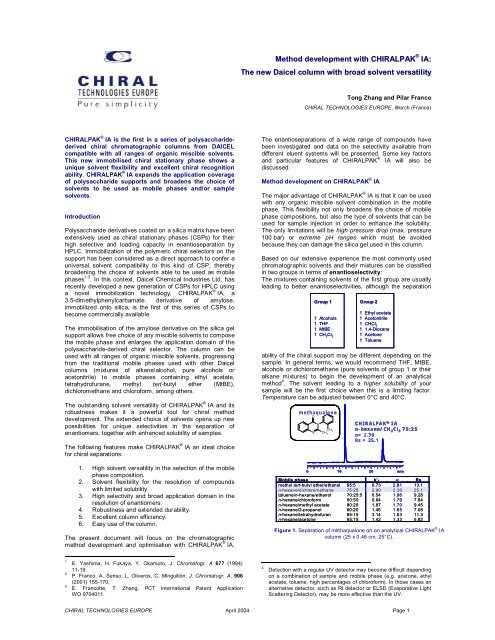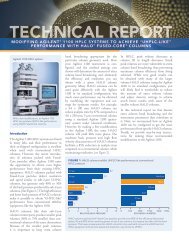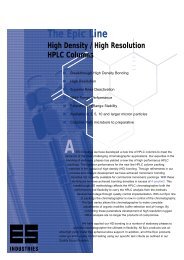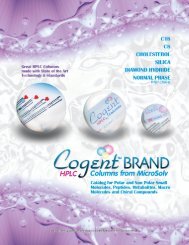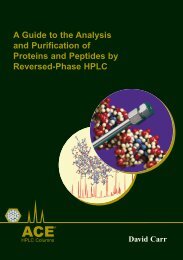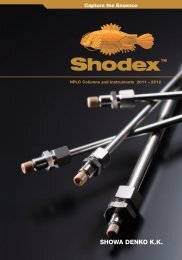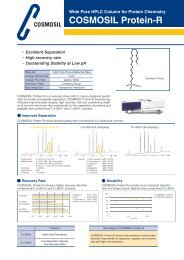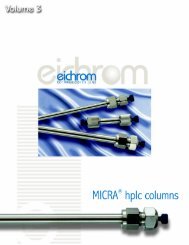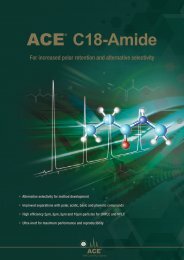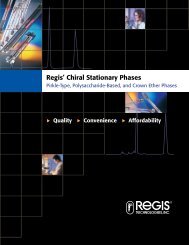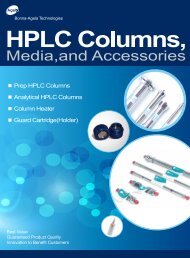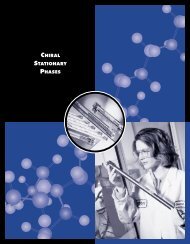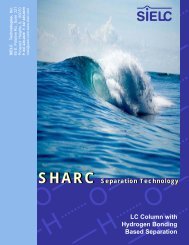Method development with CHIRALPAK IA: The new Daicel ... - Hplc.eu
Method development with CHIRALPAK IA: The new Daicel ... - Hplc.eu
Method development with CHIRALPAK IA: The new Daicel ... - Hplc.eu
Create successful ePaper yourself
Turn your PDF publications into a flip-book with our unique Google optimized e-Paper software.
<strong>Method</strong> <strong>development</strong> <strong>with</strong> <strong>CHIRALPAK</strong> ® <strong>IA</strong>:<strong>The</strong> <strong>new</strong> <strong>Daicel</strong> column <strong>with</strong> broad solvent versatilityTong Zhang and Pilar FrancoCHIRAL TECHNOLOGIES EUROPE, Illkirch (France)<strong>CHIRALPAK</strong> ® <strong>IA</strong> is the first in a series of polysaccharidederivedchiral chromatographic columns from DAICELcompatible <strong>with</strong> all ranges of organic miscible solvents.This <strong>new</strong> immobilised chiral stationary phase shows aunique solvent flexibility and excellent chiral recognitionability. <strong>CHIRALPAK</strong> ® <strong>IA</strong> expands the application coverageof polysaccharide supports and broadens the choice ofsolvents to be used as mobile phases and/or samplesolvents.IntroductionPolysaccharide derivatives coated on a silica matrix have beenextensively used as chiral stationary phases (CSPs) for theirhigh selective and loading capacity in enantioseparation byHPLC. Immobilization of the polymeric chiral selectors on thesupport has been considered as a direct approach to confer auniversal solvent compatibility to this kind of CSP, therebybroadening the choice of solvents able to be used as mobilephases 1-3 . In this context, <strong>Daicel</strong> Chemical Industries Ltd. hasrecently developed a <strong>new</strong> generation of CSPs for HPLC usinga novel immobilization technology. <strong>CHIRALPAK</strong> ® <strong>IA</strong>, a3,5-dimethylphenylcarbamate derivative of amylose,immobilized onto silica, is the first of this series of CSPs tobecome commercially available.<strong>The</strong> immobilisation of the amylose derivative on the silica gelsupport allows free choice of any miscible solvents to composethe mobile phase and enlarges the application domain of thepolysaccharide-derived chiral selector. <strong>The</strong> column can b<strong>eu</strong>sed <strong>with</strong> all ranges of organic miscible solvents, progressingfrom the traditional mobile phases used <strong>with</strong> other <strong>Daicel</strong>columns (mixtures of alkane/alcohol, pure alcohols oracetonitrile) to mobile phases containing ethyl acetate,tetrahydrofurane, methyl tert-butyl ether (MtBE),dichloromethane and chloroform, among others.<strong>The</strong> outstanding solvent versatility of <strong>CHIRALPAK</strong> ® <strong>IA</strong> and itsrobustness makes it a powerful tool for chiral method<strong>development</strong>. <strong>The</strong> extended choice of solvents opens up <strong>new</strong>possibilities for unique selectivities in the separation ofenantiomers, together <strong>with</strong> enhanced solubility of samples.<strong>The</strong> following features make <strong>CHIRALPAK</strong> ® <strong>IA</strong> an ideal choicefor chiral separations:1. High solvent versatility in the selection of the mobilephase composition.2. Solvent flexibility for the resolution of compounds<strong>with</strong> limited solubility.3. High selectivity and broad application domain in theresolution of enantiomers.4. Robustness and extended durability.5. Excellent column efficiency.6. Easy use of the column.<strong>The</strong> present document will focus on the chromatographicmethod <strong>development</strong> and optimisation <strong>with</strong> <strong>CHIRALPAK</strong> ® <strong>IA</strong>.<strong>The</strong> enantioseparations of a wide range of compounds havebeen investigated and data on the selectivity available fromdifferent eluent systems will be presented. Some key factorsand particular features of <strong>CHIRALPAK</strong> ® <strong>IA</strong> will also bediscussed.<strong>Method</strong> <strong>development</strong> on <strong>CHIRALPAK</strong> ® <strong>IA</strong><strong>The</strong> major advantage of <strong>CHIRALPAK</strong> ® <strong>IA</strong> is that it can be used<strong>with</strong> any organic miscible solvent combination in the mobilephase. This flexibility not only broadens the choice of mobilephase compositions, but also the type of solvents that can b<strong>eu</strong>sed for sample injection in order to enhance the solubility.<strong>The</strong> only limitations will be high pressure drop (max. pressure100 bar) or extreme pH ranges which must be avoidedbecause they can damage the silica gel used in this column.Based on our extensive experience the most commonly usedchromatographic solvents and their mixtures can be classifiedin two groups in terms of enantioselectivity:<strong>The</strong> mixtures containing solvents of the first group are usuallyleading to better enantioselectivities, although the separationGroup 1Group 2 Ethyl acetate Alcohols Acetonitrile THF CHCl 3 MtBE 1,4-Dioxane CH 2 Cl 2 Acetone Tolueneability of the chiral support may be different depending on thesample. In general terms, we would recommend THF, MtBE,alcohols or dichloromethane (pure solvents of group 1 or theiralkane mixtures) to begin the <strong>development</strong> of an analyticalmethod 4 . <strong>The</strong> solvent leading to a higher solubility of yoursample will be the first choice when this is a limiting factor.Temperature can be adjusted between 0°C and 40°C.methaqualoneONCH N CH 33<strong>CHIRALPAK</strong> ® <strong>IA</strong>n-hexane/CH2 Cl 2 75:25α= = 2.36Rs = 25.10 10 20 minMobile phase k’1 a Rsmethyl tert-butyl ether/ethanol 95:5 0.73 2.81 13.1n-hexane/dichloromethane 75:25 2.90 2.36 25.1toluene/n-hexane/ethanol 70:25:5 0.54 1.96 9.28n-hexane/chloroform 50:50 0.64 1.79 7.84n-hexane/methyl acetate 80:20 1.87 1.70 9.45n-hexane/2-propanol 80:20 1.45 1.65 7.08n-hexane/tetrahydrofuran 85:15 3.14 1.63 11.3n-hexane/acetone 85:15 1.42 1.33 5.82Figure 1. Separation of methaqualone on an analytical <strong>CHIRALPAK</strong> ® <strong>IA</strong>column (25 x 0.46 cm, 25°C).123E. Yashima, H. Fukaya, Y. Okamoto, J. Chromatogr. A 677 (1994)11-19.P. Franco, A. Senso, L. Oliveros, C. Minguillón, J. Chromatogr. A, 906(2001) 155-170.E. Francotte, T. Zhang, PCT International Patent ApplicationWO 9704011.4Detection <strong>with</strong> a regular UV detector may become difficult dependingon a combination of sample and mobile phase (e.g. acetone, ethylacetate, toluene, high percentages of chloroform). In those cases analternative detector, such as RI detector or ELSD (Evaporative LightScattering Detector), may be more effective than the UV.CHIRAL TECHNOLOGIES EUROPE April 2004 Page 1
In Figure 1 the separation of racemic methaqualone on<strong>CHIRALPAK</strong> ® <strong>IA</strong> <strong>with</strong> an n-hexane/dichloromethane mixture isshown. This solvent combination led to an excellent resolutionbetween the two enantiomers of this chiral drug, but a numberof different mobile phases were also able to achieveinteresting selectivity and resolution values. In the attachedtables a range of separations of methaqualone are presented(arranged according to their α values).In order to assist you <strong>with</strong> some typical starting conditions andranges for optimisation we would like to propose the followingguidelines. As previously mentioned the column allows the useof all solvent ranges, but you should find the right compositionleading to good selectivity and suitable retention times. InTable 1 you will find the classical alkane/alcohol mixtures andthe pure polar solvent combinations (alcohols and acetonitrile)being already used for coated-type polysaccharide-derivedcolumns. In Table 2 an extended series of some solvents onlycompatible <strong>with</strong> this <strong>new</strong> immobilised chiral support (seegraphical representation in Figure 2).In Tables 1 and 2 solvents are arranged according to theireluting strength. MtBE, toluene and chlorinated solvents canbe used in their pure form in the mobile phase. For fast elutingsolvents, such as THF, 1,4-dioxane or acetone, weTable 1.recommend to be used in combination <strong>with</strong> alkanes in order tomodulate the retention (Figure 3-5). Alkanes, such asn-hexane, iso-hexane or n-heptane can be used (some smallselectivity differences may sometimes be found).If we take the case of methaqualone depicted in Figure 1 wecan see that the best selectivity values were achieved <strong>with</strong>MtBE and dichloromethane solvent mixtures. Our approach toproceeding <strong>with</strong> MtBE would be to start the screening <strong>with</strong>MtBE/EtOH 98:2 (see Table 2) and then modulate theretention and/or selectivity <strong>with</strong> the addition of the alcohol.Please note that selectivity and peak shape can drasticallychange in the case of MtBE by the simple addition of a smallpercentage (usually 1-5%) of alcohol or any other of theorganic modifiers indicated in Table 2 (Figure 6). This is alsothe case for the screening <strong>with</strong> the chlorinated solvents.A screening <strong>with</strong> dichloromethane would be started <strong>with</strong> a50:50 mixture in an alkane and then the retention andselectivity would be optimised <strong>with</strong>in the advised range(between 25% and 100% of CH 2Cl 2, see Table 2).Ethanol Methanol AcetonitrileAlkane / Alkane / Alkane /EtOH 2-PrOH MeOH Typical starting conditions 100 100 100 90:10 90:10 95:5Advised optimisation range100-50% inMeOH, 2-PrOHor ACN100-50% inEtOH, 2-PrOHor ACN100-80% inMeOH, EtOHor 2-PrOH99:1 to 50:50 99:1 to 50:50 Certain alcohol mixtures have a higher viscosity. Pressure should be controlled and flow rate reduced if necessary.99:1 to50:25:25 <strong>The</strong> retention is generally shorter <strong>with</strong> a higher alcohol content. <strong>The</strong> use of other alcohols such as 1-propanol, 1- and 2-butanol etc…ispossible. No range limitation, but due to miscibility restrictions, mix methanol <strong>with</strong> an equal volume of ethanol when using <strong>with</strong> alkane mixtures,otherwise, separation of liquid phases might happen. A maximum of 5% methanol in n-hexane may be used <strong>with</strong>out adding ethanol.Table 2.MtBE /Ethanol CHCl 3 /AlkaneCH 2Cl 2 /AlkaneEthyl acetate /AlkaneTHF /Alkane1,4-Dioxane /AlkaneAcetone /AlkaneTypical starting conditions 98:2 60:40 50:50 40:60 30:70 25:75 25:75Advised optimisationrange80:20to100:025:75to100:025:75to100:020:80to70:3010:90to50:5010:90to40:6010:90to40:60 Some solvents such as MtBE, CHCl3 or CH 2Cl 2 may need the combination <strong>with</strong> alcohols (1-5%) to modulate retention times and improvepeak shape. Organic modifiers in MtBE can also be: 2-propanol, methanol, THF, ethyl acetate, methyl acetate, 1,4-dioxane or acetone.Starting percentage (%)100806040200EtOH* Alkane Alkane Alkane Alkane Alkane AlkaneMtBE CHCl 3 CH 2Cl 2 AcOEt THF Dioxane AcetoneAdvisedoptimisationrangeFigure 2. Graphical representation of the typical starting conditions and the advisedoptimisation ranges for the solvents presented in Table 2.For basic or acidic samples, it may be necessary toincorporate an additive into the mobile phase in order tooptimize the chiral separation. Basic samples may require abasic additive (diethylamine, butylamine, ethanolamine, …)and acidic compounds the addition of an acid (TFA, acetic orformic acid, …). <strong>The</strong> percentage needed is typically 0.1% andshould not exceed 0.5% (see examples in Figure 5-7).<strong>The</strong> use of <strong>CHIRALPAK</strong> ® <strong>IA</strong> is possible under reversed-phaseconditions. To make this type of operation we highlyrecommend a suitable transfer of the column through a seriesof miscible solvents and allow enough equilibration time, whichmay be longer than <strong>with</strong> organic solvents. However, it isimportant to point out that water can be adsorbed by thepolymer and the silica gel and it may be difficult to remove itafterwards. <strong>The</strong> presence of water, even in traces, may modifythe chiral recognition ability of the polysaccharide derivative.<strong>The</strong>refore, dedicated columns for normal phase applicationsare strongly recommended.CHIRAL TECHNOLOGIES EUROPE April 2004 Page 2
0.8ClLorazepamHONOHNCl1.00.8ONHOGlutethimide0.60.60.40.40.20.0n-hexanehexane/acetoneacetone60:40k 1 ’ = 1.75α= = 1.47Rs = 7.97Detection: : ELSD0.20.0n-hexanehexane/ dioxane70:30k 11 ’ = 1.65α= = 2.19Rs = 16.31Detection : ELSD0 2 4 6 8 10 12 14 16 18MinutesFigure 3. Separation of lorazepam on an analytical <strong>CHIRALPAK</strong> ® <strong>IA</strong>column (25 x 0.46 cm, 25°C, 1 mL/min).0 2 4 6 8 10 12 14 16 18MinutesFigure 4. Separation of glutethimide on an analytical <strong>CHIRALPAK</strong> ® <strong>IA</strong>column (25 x 0.46 cm, 25°C, 1 mL/min).Bupivacaine0.80.70.6NONH200OOOSNNH NH 2ClIndapamide0.51500.40.3n-hexane/THF/DEA1000.290:10:0.1k1’ = 3.94α= = 1.5550MtBE/ EtOH /DEA80:20:0.1kk 1’ 1’ = 0.670.1Rs = 8.20Detection: ELSDαα = 1.75Rs = 4.320.00Detection: : UV 270 nm0 5 10 15 20 25 30 35Minutes0 2 4 6 8 10MinutesFigure 5. Separation of bupivacaine on an analytical <strong>CHIRALPAK</strong> ® <strong>IA</strong>column (25 x 0.46 cm, 25°C, 1 mL/min).Figure 6. Separation of indapamide on an analytical <strong>CHIRALPAK</strong> ® <strong>IA</strong>column (25 x 0.46 cm, 25°C, 1 mL/min).1.00.80.6OHOOSSuprofenExamples <strong>with</strong> other solvents are shown in Figures 8-11. <strong>The</strong>behaviour of chloroform is quite similar to dichloromethane,although its eluting strength is slightly lower. Toluene cansometimes add particular enantioselectivity features to theseparation. Several excellent separations have been described<strong>with</strong> 100% toluene (i.e. bi-2-naphtol or flavanone enantiomers)and UV detection at 280 nm 5 . Nevertheless, certainseparations are achieved <strong>with</strong> mixtures containing an alkaneand a low percentage of alcohol (see examples Figures 1and 9).0.40.2n -- hexane/ethylethyl acetate /TFA70:30:0.1k 11 ’ = 2.83α= = 1.18Rs = 3.65Detection : UV 254 nm<strong>The</strong> main innovation of <strong>CHIRALPAK</strong> ® <strong>IA</strong> is the possibility ofusing the extended series of solvents presented in Table 2.However, the column is also effective <strong>with</strong> the classicalmixtures of Table 1. Two additional examples are presented inFigures 10 and 11 <strong>with</strong> polar solvents, such as pure alcoholsor acetonitrile.0.00 2 4 6 8 10 12 14 16 18 20MinutesFigure 7. Separation of suprofen on an analytical <strong>CHIRALPAK</strong> ® <strong>IA</strong>column (25 x 0.46 cm, 25°C, 1 mL/min).Reversal of the elution order can sometimes be observed <strong>with</strong>different solvents for the same compound. This feature may beperceived as an advantage when the determination of theenantiomeric excess of an enriched sample is envisaged.5Several of the examples presented in this document <strong>with</strong> an ELSDdetector can be also analysed <strong>with</strong> UV.CHIRAL TECHNOLOGIES EUROPE April 2004 Page 3
OH1.00.250.200.15H ONCH 3H 3 CCH 3 Terfenadine0.80.6OCH 3NONOCH 3 Mephobarbital0.100.40.050.00n -- hexane /CHCl 33 /DEA50:50:0.1k 11 ’ = 2.94α= = 1.72Rs = 7.84Detection : ELSD0.20.0toluene/n/n-hexane/hexane/ethanolethanol70:25:5k 1’ ’ = 0.94α= = 5.62Rs = 39.94Detection: : ELSD0 5 10 15 20 25MinutesFigure 8. Separation of terfenadine on an analytical <strong>CHIRALPAK</strong> ® <strong>IA</strong>column (25 x 0.46 cm, 25°C, 1 mL/min).0 4 8 12 16 20 24 28Figure 9. Separation of mephobarbital on an analytical <strong>CHIRALPAK</strong> ® <strong>IA</strong>column (25 x 0.46 cm, 25°C, 0.8 mL/min).O1200400O1000OONOFlavanoneH300800200600100% methanol400100k 1 ’ = 1.15α= = 2.10Rs = 10.17200100% acetonitrilek 1 ’ = 0.51α = 1.71Detection: : UV 230 nmRs = 5.3900Detection : UV 260 nm0 2 4 6 8 10 12 14MinutesFigure 10. Separation of flavanone on an analytical <strong>CHIRALPAK</strong> ® <strong>IA</strong>column (25 x 0.46 cm, 25°C, 1 mL/min).0 1 2 3 4 5 6 7 8 9MinutesFigure 11. Separation of an azetidinone derivative on an analytical<strong>CHIRALPAK</strong> ® <strong>IA</strong> column (25 x 0.46 cm, 25°C, 1 mL/min).Column cleaning and regeneration proceduresAs described in the previous section, the enantioselectivitydisplayed by the chiral column strongly depends on the correctchoice of the operating conditions (mobile phase composition,temperature, …). Furthermore, the chiral recognition ofpolysaccharide type phases also depends on thesupramolecular structure of the polymeric chiral selector. <strong>The</strong>molecular conformation can change in different solvatingenvironments. In order to ensure consistent performancesafter extensive use <strong>with</strong> different mobile phases, aregeneration method may be necessary to eliminate anyunexpected change of chiral recognition due to the history ofthe column (mobile phases, additives,…).• Flush <strong>with</strong> ethanol (0.5 ml/min for 30 min) followed by100% THF at 0.5 ml/min for 2 hours.• Flush <strong>with</strong> ethanol (0.5 ml/min for 30 min) and thenequilibrate <strong>with</strong> alkane / ethanol = 80 / 20 (v/v) priorto retesting the column.This treatment <strong>with</strong> ethanol and THF recovers the initialconformation adopted by the polymer and can even “delete”memory effects of basic or acidic additives. <strong>The</strong> insertion ofthis regeneration sequence after intensive changes betweenvery different solvent mixtures will allow you to achieve veryreproducible chromatographic results <strong>with</strong> your column.<strong>CHIRALPAK</strong> ® <strong>IA</strong>, the <strong>new</strong> immobilised <strong>Daicel</strong> column, isable to achieve unique enantioselective separations <strong>with</strong> abroader range of solvents.CHIRAL TECHNOLOGIES EUROPEParc d'InnovationBd. Gonthier d'Andernach, BP 80140F-67404 Illkirch Cedex, FRANCETel: +33-(0)3 88 79 52 00, Fax: +33-(0)3 88 66 71 66e-mail: cte@chiral.frVisit www.chiral.fr for additional information about the services offeredby CHIRAL TECHNOLOGIES EUROPE, technical support on DAICELcolumns and their applications.<strong>CHIRALPAK</strong> ® is a registered trademark of DAICEL CHEMICALINDUSTRIES Ltd.CHIRAL TECHNOLOGIES EUROPE April 2004 Page 4


